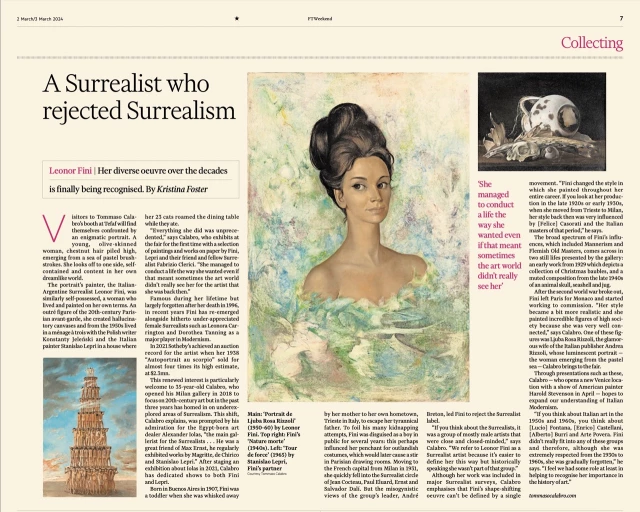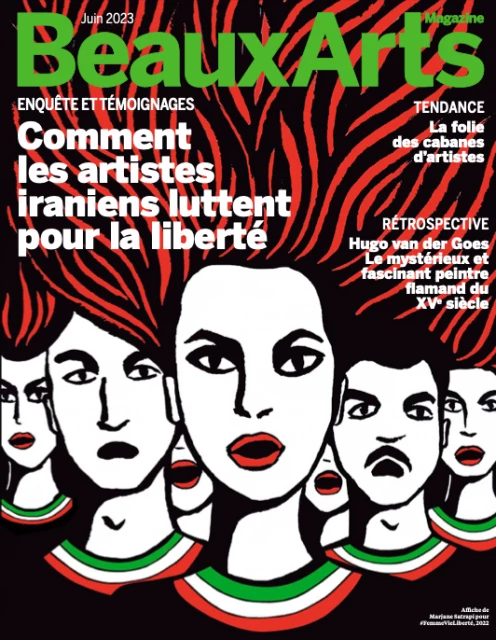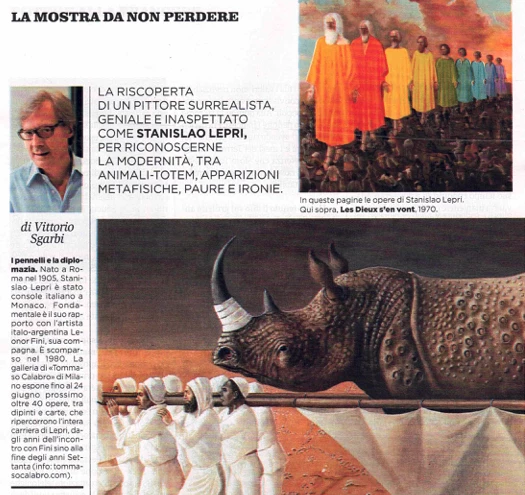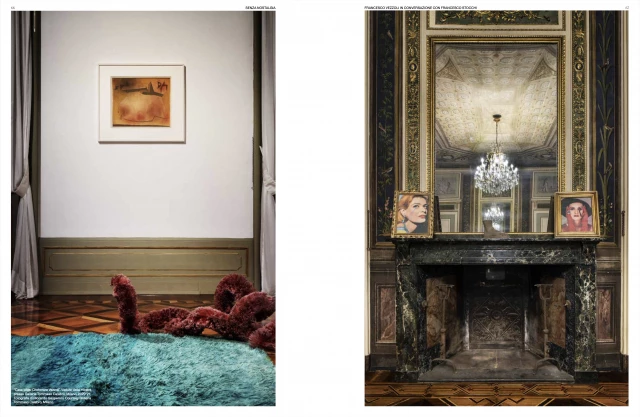Galleria Tommaso Calabro
Corso Italia 47
20122 Milan (Italy)
info@tommasocalabro.com
+39 0249696387

"It is perhaps not as central as a gallery should be, but it has great charm and meets the requirements perfectly: single entrance, large exhibition spaces and access to my apartment.» Very elegant is the home-workshop of the 34-year-old gallery owner who has chosen to divide his time between Milan and Venice: «I decided to open a gallery here because it is a city unlike any other, a city that is very connected to art, that attracts collectors and interested people all year round, especially international ones, and with a complementary universe to Milan."

"Visitors to Tommaso Calabro’s booth at the Tefaf art and antiques fair will find themselves confronted by an enigmatic portrait. A young, olive-skinned woman, chestnut hair piled high, emerging from a sea of pastel brushstrokes. She looks off to one side, self-contained and content in her own dreamlike world.
The portrait’s painter, the Italian-Argentine Surrealist Leonor Fini, was similarly self-possessed, a woman who lived and painted on her own terms. [...] “Everything she did was unprecedented,” says Calabro, who exhibits at the fair for the first time with a selection of paintings and works on paper by Fini, Lepri and their friend and fellow Surrealist Fabrizio Clerici. “She managed to conduct a life the way she wanted even if that meant sometimes the art world didn’t really see her for the artist that she was back then.”

"Nine giants in rainbow-coloured robes march in single line. The procession is somewhat enigmatic: who are these oversized figures? Are they the participants of a sad Pride march, with no cart or festive parade? What are the people at their feet fleeing?”
Painted in 1970, the work, with the evocative title 'Les dieux s'en vont' (The Gods are leaving), was made by Stanislao Lepri (1905-1980), an imaginative Italian aristocrat and diplomat, whose work is being rediscovered in an exhibition in Milan. Freed from the shackles of his social status, he abandoned his political career and became a painter, supported by his partner, the artist Leonor Fini. His strange and ambiguous canvases create a world a dark and dreamlike world. “His fantasy is never gratuitous: originating from his deepest self, it meets thecollective unconscious of our time and reflects our anxieties back to us,sweetened by a smiling irony, a tolerant wisdom,” said Constantin Jelenski, Polish man of letters and third figure in Fini's ménage à trois. His sexual freedom, as well as his artistic freedom, unhindered by dogma or certainties, made him a pioneer of the avant-garde."

"In 1987 L'Uomo Vogue published a photo by Oliviero Toscani full of testosterone: posing are seven Milanese gallery owners, young, serious and fierce in suits and ties, with the ambition to provoke and renew the market. [...] Today that the flow of ideas runs on the net as well as the market, opening up horizons without boundaries, the scene of gallery owners has also changed. With this remake of the 1987 photo we want to docu-ment it: in the selection you see on these pages there are in fact many young people and especially many women whom we brought together at Bar Basso, one of the art world's favorite meeting places."

"I almost walked past a group of what the Italian Spatialist Mario Deluigi called “grattages,” monochromes this Milan-based gallery said are making their debut in New York. They’re easy to misunderstand — they can look like upholstery — but fortunately some instinct pulled me back and I discovered that they’re almost shockingly gorgeous. Covered in intricate networks of tiny white scratches, they offer starscapes, cave drawings, the glowing wool of primordial sheep, and patterns reminiscent of calligraphy or circles of dancers à la Matisse."

"The research of a young, truly capable and tenacious Milanese gallerist, Tommaso Calabro, on the protagonists of that world of artists, separated and isolated from the dominant course of contemporary art, continues. Exemplary, in this sense, appears, after a small exhibition on Leonor Fini, Calabro's proposal of the submerged and forgotten Stanislao Lepri. [...] The laborious research of a private gallery allows us to reflect again on the substance of Lepri's dreams, endowed with an astonishing imagination that manifests itself in an iconographic variety, unprecedented in 20th Century painting. Lepri is a supremely esoteric painter, curious about the dark side of our consciousness and the dreamlike consistency of our relationship with reality. But does reality exist, or is it determined by our state of mind and our dreams? Lepri questions everything. [...] An irreducible fantasy, among rhinoceroses and cats, in apocalyptic times when the gods go away, leaving behind a humanity of desperate people. But there is still hope as long as an angel maker survives, generous and solemn."

"Fassianos never achieved widespread global recognition. But since his death in 2022, at the age of 86, there has been a wave of renewed interest. Last year, Tommaso Calabro in Milan held a solo exhibition of his paintings and works on paper."

Images from our past exhibition “Casa Iolas. Citofonare Vezzoli”, curated by Francesco Vezzoli in 2020-2021, are featured on the latest issue of Flash Art Italia.
On the occasion of the exhibition “VITA DULCIS. Paura e desiderio nell’Impero Romano” at the Palazzo delle Esposizioni in Rome, Francesco Vezzoli talks with Francesco Stocchi about his choices and vision as a curator.

"It is perhaps not as central as a gallery should be, but it has great charm and meets the requirements perfectly: single entrance, large exhibition spaces and access to my apartment.» Very elegant is the home-workshop of the 34-year-old gallery owner who has chosen to divide his time between Milan and Venice: «I decided to open a gallery here because it is a city unlike any other, a city that is very connected to art, that attracts collectors and interested people all year round, especially international ones, and with a complementary universe to Milan."

"In 1987 L'Uomo Vogue published a photo by Oliviero Toscani full of testosterone: posing are seven Milanese gallery owners, young, serious and fierce in suits and ties, with the ambition to provoke and renew the market. [...] Today that the flow of ideas runs on the net as well as the market, opening up horizons without boundaries, the scene of gallery owners has also changed. With this remake of the 1987 photo we want to docu-ment it: in the selection you see on these pages there are in fact many young people and especially many women whom we brought together at Bar Basso, one of the art world's favorite meeting places."

"Fassianos never achieved widespread global recognition. But since his death in 2022, at the age of 86, there has been a wave of renewed interest. Last year, Tommaso Calabro in Milan held a solo exhibition of his paintings and works on paper."

"Visitors to Tommaso Calabro’s booth at the Tefaf art and antiques fair will find themselves confronted by an enigmatic portrait. A young, olive-skinned woman, chestnut hair piled high, emerging from a sea of pastel brushstrokes. She looks off to one side, self-contained and content in her own dreamlike world.
The portrait’s painter, the Italian-Argentine Surrealist Leonor Fini, was similarly self-possessed, a woman who lived and painted on her own terms. [...] “Everything she did was unprecedented,” says Calabro, who exhibits at the fair for the first time with a selection of paintings and works on paper by Fini, Lepri and their friend and fellow Surrealist Fabrizio Clerici. “She managed to conduct a life the way she wanted even if that meant sometimes the art world didn’t really see her for the artist that she was back then.”

"I almost walked past a group of what the Italian Spatialist Mario Deluigi called “grattages,” monochromes this Milan-based gallery said are making their debut in New York. They’re easy to misunderstand — they can look like upholstery — but fortunately some instinct pulled me back and I discovered that they’re almost shockingly gorgeous. Covered in intricate networks of tiny white scratches, they offer starscapes, cave drawings, the glowing wool of primordial sheep, and patterns reminiscent of calligraphy or circles of dancers à la Matisse."

Images from our past exhibition “Casa Iolas. Citofonare Vezzoli”, curated by Francesco Vezzoli in 2020-2021, are featured on the latest issue of Flash Art Italia.
On the occasion of the exhibition “VITA DULCIS. Paura e desiderio nell’Impero Romano” at the Palazzo delle Esposizioni in Rome, Francesco Vezzoli talks with Francesco Stocchi about his choices and vision as a curator.

"Nine giants in rainbow-coloured robes march in single line. The procession is somewhat enigmatic: who are these oversized figures? Are they the participants of a sad Pride march, with no cart or festive parade? What are the people at their feet fleeing?”
Painted in 1970, the work, with the evocative title 'Les dieux s'en vont' (The Gods are leaving), was made by Stanislao Lepri (1905-1980), an imaginative Italian aristocrat and diplomat, whose work is being rediscovered in an exhibition in Milan. Freed from the shackles of his social status, he abandoned his political career and became a painter, supported by his partner, the artist Leonor Fini. His strange and ambiguous canvases create a world a dark and dreamlike world. “His fantasy is never gratuitous: originating from his deepest self, it meets thecollective unconscious of our time and reflects our anxieties back to us,sweetened by a smiling irony, a tolerant wisdom,” said Constantin Jelenski, Polish man of letters and third figure in Fini's ménage à trois. His sexual freedom, as well as his artistic freedom, unhindered by dogma or certainties, made him a pioneer of the avant-garde."

"The research of a young, truly capable and tenacious Milanese gallerist, Tommaso Calabro, on the protagonists of that world of artists, separated and isolated from the dominant course of contemporary art, continues. Exemplary, in this sense, appears, after a small exhibition on Leonor Fini, Calabro's proposal of the submerged and forgotten Stanislao Lepri. [...] The laborious research of a private gallery allows us to reflect again on the substance of Lepri's dreams, endowed with an astonishing imagination that manifests itself in an iconographic variety, unprecedented in 20th Century painting. Lepri is a supremely esoteric painter, curious about the dark side of our consciousness and the dreamlike consistency of our relationship with reality. But does reality exist, or is it determined by our state of mind and our dreams? Lepri questions everything. [...] An irreducible fantasy, among rhinoceroses and cats, in apocalyptic times when the gods go away, leaving behind a humanity of desperate people. But there is still hope as long as an angel maker survives, generous and solemn."